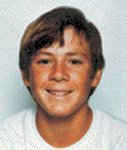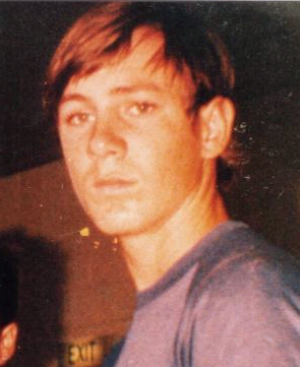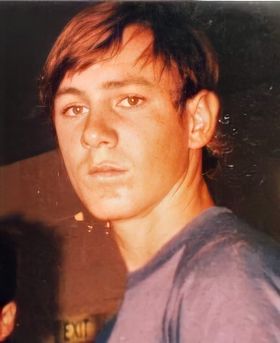Has he formally rejected a request from Mr Henry Lawson for a coronial
inquiry into the suspected death of his son, Norman, and if so, can he explain
on what basis?
ANSWER Mr Speaker, I thank the member for Arafura for giving me the
courtesy of advance notice of this question. The Norman Lawson case is a very
tragic one, particularly for the family concerned. To remind honourable members,
on Sunday 19 October 1986, Norman Lawson went to the old South Alligator
crossing with 4 other persons. On Wednesday 22 October 1980, he was seen to walk
away from the river crossing carrying a throw net. Since then he has not been
sighted. An extensive police search and investigation has failed to locate
Norman Lawson. The latest development is a recently reported sighting of Norman
in the Darwin area and that is being investigated by the Darwin CIB. The
investigation is being conducted as a missing person inquiry and is not subject
to a coronial inquest. To answer the honourable member's question specifically;
the coroner has perused the file and has found that there is insufficient
evidence to reach the conclusion that Lawson is deceased. It is not, therefore,
within his jurisdiction to conduct an inquiry and that is why there has been no
coronial inquiry. The matter has been referred to the coroner and he has said
that there is insufficient evidence that young Norman is in fact deceased and
therefore he could not conduct an inquiry. The matter is being treated seriously
by the police as a missing person inquiry and the latest sightings are being
investigated with vigour by our CIB.
October 21st, 2009
Norman Lawson was 16 when he disappeared in Kakadu.
His younger brother Murray, who now goes by the last
name Cooper, was just 14 when his brother disappeared
without a trace
THE brother of a Territory teenager who mysteriously
disappeared in Kakadu National Park 23 years ago today
wants police to re-open the cold case and find his
killer.
He said his distraught family wants answers - and
closure - over what really happened to his brother.
Norman Lawson was 16 years old when he went missing
while camping in the national park on October 21, 1986.
His camp mates told police they last saw him walking
towards the South Alligator River about 5.30pm carrying
a cast net.
Norman hasn't been seen since.
Theories about his fate have been numerous.
A coronial inquiry found it was possible the bush kid
was taken by a crocodile while police said he was likely
a teenage runaway.
But his family has remained adamant from day one that he
was murdered.
His younger brother Murray told the Northern Territory
News yesterday it was time for police to re-investigate
the matter.
"Twenty-three years on and we still have no answers," he
said.
"There is no hope he is still alive - we've accepted
that he is dead.
"But we want closure, we want to lay my brother to rest.
"We need to know what has happened to him."
Murray, who now goes by the last name Cooper, was just
14 when his brother disappeared without a trace and says
there is not a day goes by he doesn't think about him.
He said he was "absolutely disgusted" by the NT Police
investigation.
"The whole investigation was a sham," he said. "They
first kept saying he was just a runaway, then they said
it was a crocodile attack and then it was just put in
the too hard basket."
Mr Cooper, 37, who admitted to having a criminal record
but says he is a changed man, said all the evidence in
his brother's disappearance pointed to foul play.
He believes Norman was shot in the back of the head with
his own .22 Magnum rifle and that his body was buried in
the Outback.
These claims are backed up by the fact the 1990 coronial
inquiry found that his brother's rifle was sold for $170
just days after his disappearance - and it was later
discovered the barrel on the gun was packed with yellow
dirt, indicating it may have been used for digging.
Mr Lawson's murder theory rang even truer when in 1990,
skeletal remains that were found at Lake Bennett - but
are still yet to be identified - showed evidence of a
bullet hole in the skull.
"The remains included ribs, vertebrae, leg and arm bones
as well a skull, which had a shot in the back of it from
a .22 magnum - Norman had owned a gun exactly like
that," he said.
"We believe they are the remains of Norman. Back then
testing was conducted and they said it wasn't him. But
we then asked for them to be sent south for a second
opinion and we were told it was him."
"We are just confused and are calling on them to test
the bones again."
Police said yesterday Norman's disappearance was still
an open missing persons case.
They said the Coroner's Constable would be conducting a
project, overseen by the Major Crime Division, where a
number of old unidentified skeletal remains, including
those found at Lake Bennett, would be tested by new
technology.
But they said the results are not expected to be known
until next year.
Norman vanished when he was 16. His family wants to know why
Norman Lawson disappeared in Kakadu National Park more than three decades ago.
His family still doesn’t know what happened to him and is appealing for answers
as his story is told in a new book.
Published 6 July 2023 5:49am
By Emma Brancatisano
Aboriginal and Torres Strait Islander
readers are advised this article contains photos of people who have died.
Susan Lawson would give anything to know
what happened to her younger brother, Norman.
He was a “caring, gentle soul” the
54-year-old says. He was her “big protector”.
She was 17 when Norman disappeared while
on a trip with four other people to the Northern Territory’s Kakadu National
Park in 1986. He was 16.
“It’s an unbearable pain,” she says.
“If I could give anything in this world
for another family to not have to go through this, I would do it.”
The disappearance
Susan and Norman, and their other brother
Murray, moved around a lot when they were younger.
Their father was Aboriginal, from the
Iman People of Central and South Western Queensland, and they grew up mostly
in the Northern Territory.
As children, the three siblings spent
time on riverbanks and learned to live off the land. Norman would often go
off on trips, Susan says.
When their parents separated, Susan and
Norman lived with their father, and Murray lived with their mother.
“He was my life. We were very close - as
close as brother and sister could be,” Susan says of Norman.
She says Norman had always wanted to
leave school and get a job to put himself through university. He’d started a
timber and fencing business but “he wanted to become a doctor or a lawyer to
help people … and then come back and live with his family,” she says.
In 1986, Norman had been living in a camp
in Howard Springs, about 30 kilometres from the centre of Darwin, and close
to his father’s house in nearby Palmerston. Sometime after 19 October that
year, he went on a trip with a group of four other people from the camp —
two men and two women.
The group travelled to the area of the
Old Jim Jim Road in Kakadu, near the South Alligator River. The national
park is about three hours from Darwin and is a known habitat for saltwater
crocodiles.
Susan says when Norman didn’t return to
their father’s house as he was expected to after the trip, their father
notified police.
A Coroner’s report would later find the
four people Norman was with on the trip failed to “properly notify anyone in
authority” at nearby Cooinda or Jabiru that Norman was missing.
Two of the four people did not return to
Darwin.
The search
A search of the area started on Monday 27
October and continued for five days.
A helicopter was called in to help, but
Susan alleges that was under the pressure of the family.
“We had to fight to get the helicopters
in. We had to fight for this, fight for that. It was terrible,” she says.
Norman was never found.
She believes Norman’s heritage played a
role in the subsequent investigation.
“I do believe that at the top, it was
‘just another black kid gone missing. Don’t worry about it’. The runaway
sort of thing, you know?” she says.
“The problem is there are so many people,
so many families in the same boat.”
The theories
In June 1990, following an inquest, the
NT Coroner ruled Norman had died during the trip.
Norman “died in the area of the Old Jim
Jim Road Crossing of the South Alligator River” on or about Tuesday 21 or
Wednesday 22 October 1986, the Coroner’s report says.
“Over three years have elapsed since
Norman Lawson disappeared and despite an extensive ongoing investigation by
the Northern Territory Police, no factors have emerged which would tend to
indicate he may still be alive,” the Coroner said.
The Coroner said it was possible Norman
was taken by a crocodile on the day he disappeared from his camp, but that
they were unable to make a conclusive finding about the cause of death.
They said while the behaviour of the
people Norman was on the trip with when “viewed in isolation may be regarded
as questionable, when the whole of the evidence is examined there is not
sufficient evidence to commit any person for trial”.
But Susan suspects foul play.
“We believe in our heart of hearts, there
was no way in the world he was taken by a crocodile,” she says.
If he was, she claims, it would have been
if he was killed by someone first and then “fed to the crocodiles”.
The missing
Thirty-seven years on, Norman’s story is
being told in a new book, released last month. Vanished explores
lesser-told stories of missing persons from the perspectives of their
siblings.
“I wanted to tell stories that people
don’t already know,” the book’s author Nicole Morris says.
“These families are just as important as
the high-profile cases.”
Morris, too, suspects there is more to
Norman's story.
“This is a 16-year-old boy who was
murdered and no one is remembering him,” she claims.
“People need to recognise what happened
instead of just thinking he was another missing Indigenous kid, which is so
unfair and diminishes his value as a person,” she says.
“Norman’s life meant something”.
In 2005, Morris set up the Australian
Missing Persons Register, a not-for-profit association that provides
information on missing person cases and support to their loved ones.
Fifteen years later, Norman’s brother
Murray got in touch.
“Murray messaged me and said, ‘That's my
brother you’re talking about, and you’ve got it wrong,’” Morris says.
“Everybody says that he was on a fishing
trip. And he wasn’t,’” he told her.
In the book, Murray and Susan say their
brother was always described as being on a “fishing expedition” when he
disappeared, including in the Coroner’s report and in Morris's appeals for
information, but that he was only camping.
“People get the wrong impression, that
they were in a boat — there was no boat. They were on land … There’s a lot
of untold stories, untold truths,” Murray says in the book.
“Someone has to know something,” he told
SBS News.
Morris has a specific page in her
database for missing Indigenous people, which she estimates to be “a couple
of thousand”.
Her database is different to the official
Australian Federal Police (AFP) National Missing Persons Coordination Centre
(NMPCC). Norman does not appear on the AFP’s database.
The remains
A person is still considered missing
until their remains are found. It is something that Susan still struggles
with.
In 1990, skeletal remains were found at
Lake Bennett, about a 300-kilometre drive from Old Jim Jim Road. The family
were told “conflicting information about the identity of the remains,”
Morris writes in the book.
“We were told it was Norman, then we were
told it wasn’t,” Susan says.
“From my understanding, to this day, I
believe those remains still haven’t been identified … We haven’t actually
had a formal answer.”
But when SBS News contacted NT Police,
Detective Acting Sergeant Glen Chatto said the remains had been identified
and confirmed they were not Norman.
“This particular case is not related to
Mr Lawson and is a separate ongoing investigation,” Chatto said via email.
A spokesperson for the Coroner’s office
also confirmed to SBS News the remains located at Lake Bennett were formally
identified and found not to be Norman.
Chatto said: “I’m not aware of the
conflicting information and I would be happy to meet with [Norman’s] family
to discuss this”.
Murray told SBS News he had already been
made aware that the remains were not Norman, but Susan said it was new
information to her.
“I have never ever been told that. That’s
why I’ve always had that glimmer of hope that it might have been, and that
one day, I would get the good news.
“I hope whoever’s family it was were able
to put their loved one to rest.”
The aftermath
Chatto said “significant investigations”
took place to find Norman and “to date have not been able to determine exact
circumstances around his disappearance”.
“Numerous calls for information through
media campaigns were conducted including a reward of $50,000 for information
offered in 1990.”
Norman is not listed on the AFP database
as it did not exist at the time of the investigation, he said.
Norman is today considered a Long Term
Missing Person (LTMP).
“The NT Police Missing Persons Unit are
in the process of auditing all NT LTMP cases and updating the database
through written requests to the AFP on a case-by-case basis”, Chatto said.
“Four LTMP cases have been resolved by
UHR [unidentified human remains] identification in the last two years. No
UHR located within the NT has been identified as Norman Lawson.”
When asked whether Norman’s Indigenous
heritage played a role in the response to the investigation, an NT Police
spokesperson said: “All reported Long Term Missing Persons cases remain open
and are investigated by NT Police without fear or favour”.
Susan says not knowing what happened to
Norman is a burden that has passed onto her relationship with her children
and grandchildren.
“All I want to do is keep them safe and
not let anything happen to them like my brother,” she says.
“Mum and Dad died not knowing what
happened to their son. I would not like to die not knowing what happened to
my brother.”
Vanished:
True stories from families of Australian missing persons, by Nicole Morris,
is published by Big Sky Publishing.
If you have any information on missing
persons, contact Crime Stoppers on 1800 333 000.


